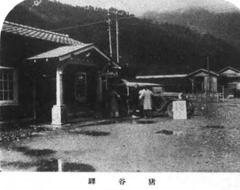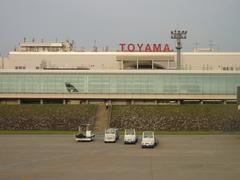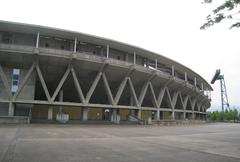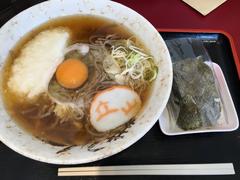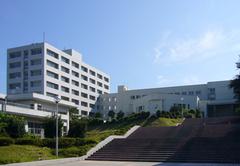
Toyama Municipal Family Park Zoo: Visiting Hours, Tickets, Travel Guide, and Conservation Highlights
Introduction
Nestled in the scenic Kureha Heights on the western edge of Toyama City, Toyama Municipal Family Park Zoo is a premier destination for families, wildlife enthusiasts, and travelers seeking a balance of recreation, education, and conservation. Since its establishment in 1984, the zoo has evolved from a local recreational site into a center for biodiversity awareness, environmental stewardship, and cultural enrichment. With a focus on native Japanese species—such as the Japanese serow, raccoon dog (tanuki), and the endangered rock ptarmigan—the zoo provides visitors with immersive exhibits, hands-on educational programs, and engaging community events.
Toyama Municipal Family Park Zoo’s accessible layout, family-friendly amenities, and proximity to Toyama’s historical sites make it a key part of any regional itinerary. This guide presents detailed information on visiting hours, ticketing, transportation, facilities, animal encounters, special events, and conservation initiatives, empowering you to plan an enriching and memorable visit.
For the latest updates, tickets, and event information, consult the official Toyama Municipal Family Park website, and explore further through resources like Toyama Prefecture Museums and the Japanese Association of Zoos and Aquariums (JAZA).
Historical Background and Significance
Founding Vision and Growth
Founded in 1984, the zoo’s original mission was to foster public understanding of Toyama’s unique flora and fauna while offering a green retreat for city residents (Toyama Municipal Family Park official site). Early planning involved environmental organizations and local government, signifying a community-driven approach to conservation and education (Toyama Prefecture Museums).
Expansion and Conservation
The zoo’s mission has broadened to prioritize the protection and breeding of endangered and indigenous species, as well as the preservation of the satoyama (woodland) landscape. Notable facility expansions include the Bird House, Red Panda House, and Nature Experience Center, all designed to enhance animal welfare and public engagement. By 2022, the zoo had welcomed over 10 million visitors, cementing its role as a beloved regional attraction (Toyama Municipal Family Park official site).
Conservation Leadership
Home to over 700 animals representing around 94 species, the zoo is especially recognized for its conservation programs. Its work with the endangered Japanese rock ptarmigan (raichō) is particularly significant, positioning the zoo as a national leader in ex-situ species preservation (Toyama Prefecture Museums).
Visitor Information
Visiting Hours
- Open: Daily except Wednesdays and year-end holidays
- Hours: 9:00 AM – 5:00 PM (last admission at 4:30 PM)
- Note: Hours may vary for special events or seasonal changes. Always confirm via the official website.
Ticket Prices
- Adults: ¥600–¥700 (check for updates)
- Children (elementary & junior high): ¥300
- Preschoolers: Free
- Seniors (65+): ¥500 (when applicable)
- Group Discounts: Available for 20+ persons
- Toyama City residents and other categories may receive additional discounts.
Getting There
- By Train/Bus: From Toyama Station, take a bus to the Family Park Zoo stop (approx. 15 minutes).
- By Car: Accessible via the Hokuriku Expressway, with free on-site parking (NAVITIME JAPAN).
Facilities and Accessibility
The zoo is designed to accommodate all visitors:
- Wheelchair-friendly paths and accessible restrooms
- Stroller rentals (available at the entrance)
- Nursing rooms, shaded rest areas, and coin lockers
- Audio guides, tactile exhibits, and sign language interpretation
- Sensory-friendly programs for visitors with sensory sensitivities
Key Attractions and Experiences
Themed Zones and Play Areas
Toyama Municipal Family Park Zoo features multiple themed zones, playgrounds, and picnic spots. Children enjoy interactive experiences at the petting zoo, while playgrounds and seasonal flower gardens add to the family-friendly atmosphere.
Animal Exhibits
Signature habitats include:
- Japanese Macaque Enclosure: Naturalistic setting for native monkeys
- Red Panda Habitat: Multi-level viewing for one of the zoo’s stars
- Aviary and Waterfowl Pond: Walk-through aviary and wetland birds
- Hoofed Animal Paddocks: Deer, goats, and sheep in satoyama-inspired landscapes
- Capybara Baths: In winter, capybaras enjoy traditional bamboo-heated baths (Mainichi Japan)
Seasonal Events and Educational Programs
Popular events include the “Morning Family Park Special Opening,” “Night Zoo,” and spring/autumn festivals. Keeper talks, animal feeding demonstrations, and eco-craft workshops are held regularly (Toyama Municipal Family Park official site).
Animal Collection and Conservation
Species Diversity
The zoo prioritizes native Japanese species while showcasing select exotics:
- Mammals: Japanese macaques, red pandas, sika deer, raccoon dogs, Japanese serow, capybaras
- Birds: Cranes, pheasants, owls, and the rare rock ptarmigan
- Reptiles, Amphibians, and Invertebrates: Highlighting regional biodiversity
Signature Conservation: The Japanese Rock Ptarmigan
Toyama Municipal Family Park Zoo is integral to the national effort to save the endangered Japanese rock ptarmigan (Lagopus muta japonica). Through a partnership with the Ministry of the Environment and other institutions, the zoo leads in:
- Captive breeding: Artificial incubation and rearing of chicks from wild-collected eggs (JPN-PSA: Ex situ conservation of Lagopus muta)
- Research: Innovations in breeding, chick rearing, and preparation for future reintroduction
- Public education: Interpretive exhibits and seasonal viewing of ptarmigan chicks
Broader Biodiversity Initiatives
The zoo participates in JAZA-led conservation campaigns, biodiversity monitoring, and habitat restoration projects. Community members can join citizen science activities, workshops, and volunteer opportunities (JPN-PSA: Biodiversity Conservation).
Educational and Community Programs
- Animal Encounter Sessions: Supervised animal interactions and keeper talks
- School and Group Visits: Curriculum-aligned tours and activities (over 120 school groups in 2024)
- Workshops and Citizen Science: Birdhouse building, plantings, and wildlife surveys
- Community Events: Seasonal festivals, World Wildlife Day, Earth Day celebrations
- Volunteer/Internship Opportunities: For students and community members
- Environmental Education Center: Interactive exhibits and public lectures
- Digital Learning: Virtual tours, live streams, and downloadable materials
- Support for Educators: Professional development and classroom resource kits
Practical Travel Tips
- Arrive Early: Enjoy quiet trails and animal activity before peak hours
- Check Event Schedules: Plan your visit around feedings and special events
- Dress Comfortably: Sturdy shoes, weather-appropriate clothing
- Picnic-Friendly: Bring your own food or enjoy café offerings
- Weather: Spring and autumn are ideal; winter highlights include capybara baths (Mainichi Japan)
- Language: Signage in basic English; translation apps can enhance your experience
Nearby Toyama Historical Sites and Attractions
Combine your zoo visit with local culture:
- Toyama Castle Park: Restored castle and gardens
- Toyama Glass Art Museum: Contemporary glass art exhibitions
- Kansui Park and Kurobe Gorge Railway: Scenic spots and family outings Find more at NAVITIME JAPAN and Wanderlog.
Frequently Asked Questions (FAQ)
Q: What are the zoo’s opening hours?
A: Generally 9:00 AM–5:00 PM (last entry 4:30 PM), closed Wednesdays and holidays. Check the official website for changes.
Q: How much are tickets?
A: Adults ¥600–¥700, children ¥300, preschoolers free; discounts for seniors and groups.
Q: Is the zoo wheelchair accessible?
A: Yes—paved paths, accessible restrooms, and rental options.
Q: Are there guided tours?
A: Yes—arrange in advance or join scheduled programs.
Q: Can I bring my own food?
A: Yes—picnic areas are available.
Q: What’s special in winter?
A: Capybara baths and unique snowy scenery.
Visuals and Media
- Images: Red pandas, macaques, capybaras in bath, ptarmigans—use descriptive alt tags for accessibility and SEO.
- Maps: Show zoo location relative to Toyama City.
- Videos: Virtual tours and event highlights are available on the zoo’s website.
Conclusion and Recommendations
Toyama Municipal Family Park Zoo is a model for integrating wildlife conservation, lifelong learning, and community recreation. With its accessible facilities, dynamic events, and leading conservation efforts—especially for the rock ptarmigan—it stands out among Toyama’s attractions. Whether you’re traveling with family, interested in nature, or seeking cultural enrichment, the zoo offers a rewarding, multifaceted experience.
Plan your visit by checking the latest hours and ticket information on the official website, and enhance your experience with the Audiala app and related travel guides. Don’t miss the chance to connect with Toyama’s wildlife, culture, and conservation movement.
References
- Toyama Municipal Family Park official site
- Toyama Prefecture Museums
- Japanese Association of Zoos and Aquariums (JAZA) – Toyama Municipal Family Park Zoo Profile
- Ex-situ Conservation of Lagopus muta (Rock Ptarmigan) Progress Report
- NAVITIME Japan Travel Guide – Toyama Family Park
- Mainichi Japan – Capybara Bath Feature
- Trip.com – Toyama Family Park Overview
- Wanderlog – Toyama Family Park Visitor Information

